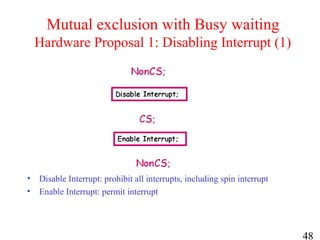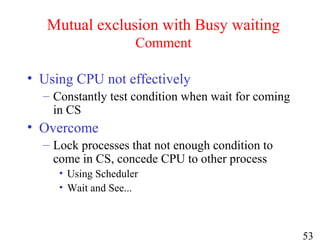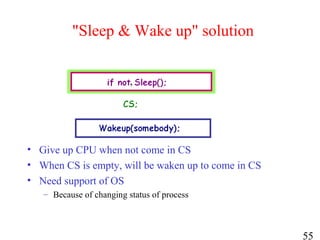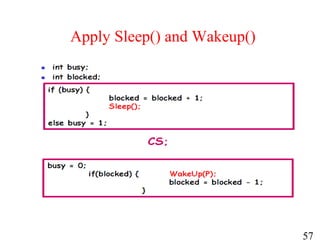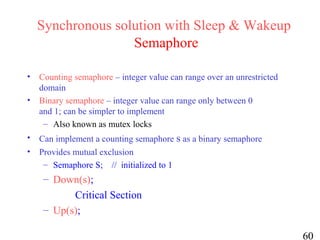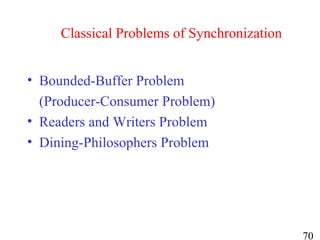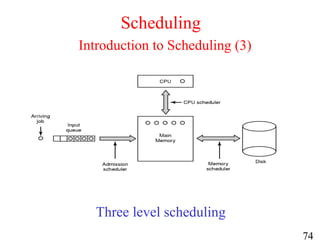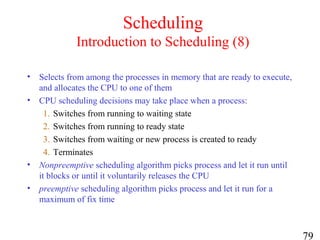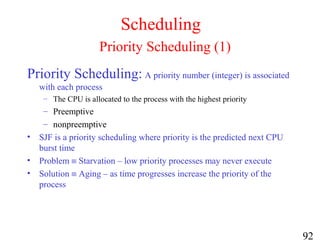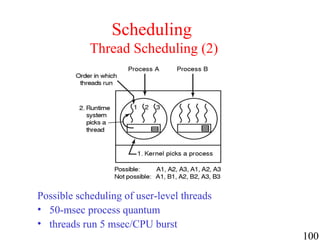Processes and Thread OS_Tanenbaum_3e
- 1. 1 Processes and Threads Part 2 2.1 Processes 2.2 Threads 2.3 Interprocess communication 2.4 Scheduling
- 3. 3 Processes The Process Model • (a) Multiprogramming of four programs • (b) Conceptual model of 4 independent, sequential processes • (c) Only one program active at any instant
- 4. 4 Processes Process Concept • An operating system executes a variety of programs: – Batch system – jobs – Time-shared systems – user programs or tasks • Process – a program in execution; process execution must progress in sequential fashion • A process resources includes: – Address space (text segment, data segment) – CPU (virtual) • program counter • registers • stack – Other resource (open files, child processes…)
- 6. 6 Processes Process Creation (1) Principal events that cause process creation 1. System initialization 2. Execution of a process creation system Call 3. User request to create a new process 4. Initiation of a batch job
- 7. 7 Processes Process Creation (2) • Address space – Child duplicate of parent – Child has a program loaded into it • UNIX examples – fork system call creates new process – exec system call used after a fork to replace the process’ memory space with a new program
- 8. 8 Processes Process Creation (3) : Example
- 9. 9 Processes Process Termination Conditions which terminate processes 1. Normal exit (voluntary) 2. Error exit (voluntary) 3. Fatal error (involuntary) 4. Killed by another process (involuntary)
- 10. 10 Processes Process Hierarchies • Parent creates a child process, child processes can create its own process • Forms a hierarchy – UNIX calls this a "process group" • Windows has no concept of process hierarchy – all processes are created equal
- 11. 11 Processes Process States (1) • Possible process states – running – blocked – ready • Transitions between states shown
- 12. 12 Processes Process States (2) • Lowest layer of process-structured OS – handles interrupts, scheduling • Above that layer are sequential processes
- 13. 13 Processes Process Control Block (PCB)
- 15. 15 Processes Implementation of Processes (1) Fields of a process table entry
- 16. 16 CPU utilization as a function of the number of processes in memory. Modeling Multiprogramming
- 17. 17 2.2 Threads
- 18. 18 Threads The Thread Model (a) Three processes each with one thread (b) One process with three threads - A thread – Lightweight Process is a basic unit of CPU utilization
- 19. 19 Threads Process with single thread • A process (heavyweight): – Address space (text section, data section) – Single thread of execution • program counter • registers • Stack – Other resource (open files, child processes…)
- 20. 20 Threads Process with multiple threads Multiple threads of execution in the same environment of process – Address space (text section, data section) – Multiple threads of execution, each thread has private set: • program counter • registers • stack – Other resource (open files, child processes…)
- 21. 21 Threads Single and Multithreaded Processes PC PC PC PC
- 22. 22 Threads Items shared and Items private • Items shared by all threads in a process • Items private to each thread
- 23. 23 Threads Benefits • Responsiveness • Resource Sharing • Economy • Utilization of Multiprocessor Architectures
- 24. 24 Threads Thread Usage (1) A word processor with three threads
- 25. 25 Threads Thread Usage (2) A multithreaded Web server
- 26. 26 Threads Thread Usage (3) • Rough outline of code for previous slide (a) Dispatcher thread (b) Worker thread
- 27. 27 Threads Implementing Threads in User Space (1) A user-level threads package
- 28. 28 Threads Implementing Threads in User Space (2) • Thread library, (run-time system) in user space • thread_create • thread_exit • thread_wait • thread_yield (to voluntarily give up the CPU) • Thread control block (TCB) ( Thread Table Entry) stores states of user thread (program counter, registers, stack) • Kernel does not know the present of user thread
- 29. 29 Threads Implementing Threads in User Space (3) thread library u u u thread library u u u thread library u u u user thread kernel • Traditional OS provide only one “kernel thread” presented by PCB for each process. – Blocking problem: If one user thread is blocked ->the kernel thread is blocked, -> all other threads in process are blocked. PCBPCB PCB
- 30. 30 Threads Implementing Threads in the Kernel (1) A threads package managed by the kernel
- 31. 31 Threads Implementing Threads in the Kernel (2) • Multithreading is directly supported by OS: – Kernel manages processes and threads – CPU scheduling for thread is performed in kernel • Advantage of multithreading in kernel – Is good for multiprocessor architecture – If one thread is blocked does not cause the other thread to be blocked. • Disadvantage of Multithreading in kernel – Creation and management of thread is slower
- 32. 32 Threads Hybrid Implementations Multiplexing user-level threads onto kernel- level threads
- 34. 34 Cooperating Processes • Independent process cannot affect or be affected by the execution of another process • Cooperating process can affect or be affected by the execution of another process • Advantages of process cooperation – Information sharing – Computation speed-up – Modularity – Convenience
- 35. 35 Problem of shared data • Concurrent access to shared data may result in data inconsistency • Maintaining data consistency requires mechanisms to ensure the orderly execution of cooperating processes • Need of mechanism for processes to communicate and to synchronize their actions
- 36. 36 Race Conditions • Two processes want to access shared memory at same time and the final result depends who runs precisely, are called race condition • Mutual exclusion is the way to prohibit more than one process from accessing to shared data at the same time • Example of race condition
- 37. 37 Critical Regions (1) The Part of the program where the shared memory is accessed is called Critical Regions (Critical Section) Four conditions to provide mutual exclusion 1. No two processes simultaneously in critical region 2. No assumptions made about speeds or numbers of CPUs 3. No process running outside its critical region may block another process 4. No process must wait forever to enter its critical region
- 38. 38 Critical Regions (2) Mutual exclusion using critical regions (Example)
- 39. 39 Solution: Mutual exclusion with Busy waiting • Software proposal – Lock Variables – Strict Alternation – Peterson's Solution • Hardware proposal – Disabling Interrupts – The TSL Instruction
- 40. 40 Mutual exclusion with Busy waiting Software Proposal 1: Lock Variables
- 41. 41 Mutual exclusion with Busy waiting Software Proposal 1: Event
- 42. 42 Mutual exclusion with Busy waiting Software Proposal 2: Strict Alternation
- 43. 43 Mutual exclusion with Busy waiting Software Proposal 2: Strict Alternation • Only 2 processes • Responsibility Mutual Exclusion – One variable "turn“, one process “turn” come in CS at the moment.
- 44. 44 Mutual exclusion with Busy waiting Software Proposal 3: Peterson's Solution Boolean
- 45. 45 Mutual exclusion with Busy waiting Software Proposal 3: Peterson's Solution
- 46. 46 Mutual exclusion with Busy waiting Comment for Software Proposal 3: Peterson's Solution • Satisfy 3 conditions: – Mutual Exclusion • Pi can enter CS when interest[j] == F, or turn == i • If both want to come back, because turn can only receive value 0 or 1, so one process enter CS – Progress • Using 2 variables distinct interest[i] ==> opposing cannot lock – Bounded Wait: both interest[i] and turn change value • Not extend into N processes
- 47. 47 Mutual exclusion with Busy waiting Comment for Busy-Waiting solutions • Don't need system’s support • Hard to extend • Solution 1 is better when atomicity is supported
- 48. 48 Mutual exclusion with Busy waiting Hardware Proposal 1: Disabling Interrupt (1) • Disable Interrupt: prohibit all interrupts, including spin interrupt • Enable Interrupt: permit interrupt
- 49. 49 Mutual exclusion with Busy waiting Hardware proposal 1: Disable Interrupt (2) • Not be careful – If process is locked in CS? • System Halt – Permit process use command privileges • Danger! • System with N CPUs? – Don't ensure Mutual Exclusion
- 50. 50 Mutual exclusion with Busy waiting Hardware proposal 2: TSL Instruction • CPU support primitive Test and Set Lock – Return a variable's current value, set variable to true value – Cannot divide up to perform (Atomic)
- 51. 51 Mutual exclusion with Busy waiting Hardware proposal 2: Applied TSL
- 52. 52 Mutual exclusion with Busy waiting Comment for hardware solutions • Necessary hardware mechanism's support – Not easy with n-CPUs system • Easily extend to N processes
- 53. 53 Mutual exclusion with Busy waiting Comment • Using CPU not effectively – Constantly test condition when wait for coming in CS • Overcome – Lock processes that not enough condition to come in CS, concede CPU to other process • Using Scheduler • Wait and See...
- 54. 54 Synchronous solution with Sleep & Wakeup – Semaphore – Monitor – Message passing
- 55. 55 "Sleep & Wake up" solution • Give up CPU when not come in CS • When CS is empty, will be waken up to come in CS • Need support of OS – Because of changing status of process ,
- 56. 56 "Sleep & Wake up" solution: Idea • OS support 2 primitive: – Sleep(): System call receives blocked status – WakeUp(P): P process receives ready status • Application – After checking condition, coming in CS or calling Sleep() depend on result of checking – Process that using CS before, will wake up processes blocked before
- 57. 57 Apply Sleep() and Wakeup()
- 58. 58 Problem with Sleep & WakeUp • Reason: – Checking condition and giving up CPU can be broken – Lock variable is not protected
- 59. 59 Synchronous solution with Sleep & Wakeup Semaphore • Suggested by Dijkstra, 1965 • Properties: Semaphore s (special integer variable;) – Unique value – Manipulate with 2 primitives: • Down(s), (Originally called P(s)) • Up(s), (Originally called V(s)) – Down and Up primitives executed cannot divide up (atomic)
- 60. 60 Synchronous solution with Sleep & Wakeup Semaphore • Counting semaphore – integer value can range over an unrestricted domain • Binary semaphore – integer value can range only between 0 and 1; can be simpler to implement – Also known as mutex locks • Can implement a counting semaphore s as a binary semaphore • Provides mutual exclusion – Semaphore S; // initialized to 1 – Down(s); Critical Section – Up(s);
- 61. 61 Synchronous solution with Sleep & Wakeup Install Semaphore (Sleep & Wakeup) • With each semaphore there is an associated waiting queue. Each entry in a waiting queue has two data items: – value (of type integer) – pointer to next record in the list • Two operations: – Sleep(): – place the process invoking the operation on the appropriate waiting queue. – WakeUp(): – remove one of processes in the waiting queue and place it in the ready queue.
- 62. 62 Synchronous solution with Sleep & Wakeup Install Semaphore (Sleep & Wakeup)
- 63. 63 Synchronous solution with Sleep & Wakeup Install Semaphore (Sleep & Wakeup)
- 64. 64 Synchronous solution with Sleep & Wakeup Using Semaphore
- 65. 65 Synchronous solution with Sleep & Wakeup Monitor • Hoare (1974) & Brinch (1975) • Synchronous mechanism is provided by programming language – Support with functions, such as Semaphore – Easier for using and detecting than Semaphore • Ensure Mutual Exclusion automatically • Using condition variable to perform Synchronization
- 66. 66 Synchronous solution with Sleep & Wakeup Monitor: structure
- 67. 67 Synchronous solution with Sleep & Wakeup Monitor: structure monitor monitor-name { shared variable declarations procedure body P1 (…) { . . . } procedure body P2 (…) { . . . } procedure body Pn (…) { . . . } { initialization code } }
- 68. 68 Synchronous solution with Sleep & Wakeup Using Monitor
- 69. 69 Synchronous solution with Sleep & Wakeup Message Passing • Processes must name each other explicitly: – send (P, message) – send a message to process P – receive(Q, message) – receive a message from process Q • Properties of communication link – Links are established automatically – A link is associated with exactly one pair of communicating processes – Between each pair there exists exactly one link – The link may be unidirectional, but is usually bi- directional
- 70. 70 Classical Problems of Synchronization • Bounded-Buffer Problem (Producer-Consumer Problem) • Readers and Writers Problem • Dining-Philosophers Problem
- 72. 72 Scheduling Introduction to Scheduling (1) • Maximum CPU utilization obtained with multiprogramming • CPU–I/O Burst Cycle – Process execution consists of a cycle of CPU execution and I/O wait • CPU burst distribution
- 73. 73 Scheduling Introduction to Scheduling (2) • Bursts of CPU usage alternate with periods of I/O wait – (a) a CPU-bound process – (b) an I/O-bound process
- 74. 74 Scheduling Introduction to Scheduling (3) Three level scheduling
- 75. 75 Scheduling Introduction to Scheduling (4) • Job Scheduler: higher-level scheduler – Job scheduling responsibilities – Job initiation based on certain criteria • Job Scheduler functions – Selects incoming job from queue – Places in process queue – Decides on job initiation criteria • Process scheduling algorithm and priority
- 76. 76 Scheduling Introduction to Scheduling (5) • Goal Job Scheduler – Sequence jobs • Efficient system resource utilization – Balance I/O interaction and computation – Keep most system components busy most of time
- 77. 77 Scheduling Introduction to Scheduling (6) • Process (CPU) Scheduler: lower-level scheduler – Process scheduling responsibilities – Determines execution steps – Process scheduling based on certain criteria • Process Scheduler functions – Determines job to get CPU resource • When and how long – Decides interrupt processing – Determines queues for job movement during execution – Recognizes job conclusion • Determines job termination • Lower-level scheduler in the hierarchy
- 78. 78 Scheduling Introduction to Scheduling (7) • Middle-level scheduler: third layer • Found in highly interactive environments – Handles overloading • Removes active jobs from memory • Reduces degree of multiprogramming – Results in faster job completion • Single-user environment – No distinction between job and process scheduling – One job active at a time • Receives dedicated system resources for job duration
- 79. 79 Scheduling Introduction to Scheduling (8) • Selects from among the processes in memory that are ready to execute, and allocates the CPU to one of them • CPU scheduling decisions may take place when a process: 1. Switches from running to waiting state 2. Switches from running to ready state 3. Switches from waiting or new process is created to ready 4. Terminates • Nonpreemptive scheduling algorithm picks process and let it run until it blocks or until it voluntarily releases the CPU • preemptive scheduling algorithm picks process and let it run for a maximum of fix time
- 80. 80 Scheduling Introduction to Scheduling (9) readyready runningrunning dispatch interrupt I/O or event completion I/O or event wait newnew terminatedterminated waitingwaiting admit exit
- 81. 81 Scheduling Introduction to Scheduling (10) Scheduling Criteria • CPU utilization – keep the CPU as busy as possible • Throughput – # of processes that complete their execution per time unit • Turnaround time – amount of time to execute a particular process • Waiting time – amount of time a process has been waiting in the ready queue • Response time – amount of time it takes from when a request was submitted until the first response is produced, not output (for time-sharing environment)
- 82. 82 Scheduling Introduction to Scheduling (11) Optimization Criteria • Max CPU utilization • Max throughput • Min turnaround time • Min waiting time • Min response time
- 83. 83 Scheduling Introduction to Scheduling (12) Scheduling Algorithm Goals
- 84. 84 Scheduling Scheduling in Batch Systems (1) First-Come, First-Served (FCFS) Scheduling Process Burst Time P1 24 P2 3 P3 3 • Suppose that the processes arrive in the order: P1 , P2 , P3 The Gantt Chart for the schedule is: • Waiting time for P1 = 0; P2 = 24; P3= 27 • Average waiting time: (0 + 24 + 27)/3 = 17 P1 P2 P3 24 27 300
- 85. 85 Scheduling Scheduling in Batch Systems (2) FCFS Scheduling (Cont.) Suppose that the processes arrive in the order P2 , P3 , P1 • The Gantt chart for the schedule is: • Waiting time for P1 = 6;P2 = 0;P3 = 3 • Average waiting time: (6 + 0 + 3)/3 = 3 • Much better than previous case • Convoy effect short process behind long process P1P3P2 63 300
- 86. 86 Scheduling Scheduling in Batch Systems (3) Shortest-Job-First (SJF) Scheduling • Associate with each process the length of its next CPU burst. Use these lengths to schedule the process with the shortest time • Two schemes: – nonpreemptive – once CPU given to the process it cannot be preempted until completes its CPU burst – preemptive – if a new process arrives with CPU burst length less than remaining time of current executing process, preempt. This scheme is know as the Shortest-Remaining-Time-First (SRTF) • SJF is optimal – gives minimum average waiting time for a given set of processes
- 87. 87 Process Arrival Time Burst Time P1 0.0 7 P2 2.0 4 P3 4.0 1 P4 5.0 4 • SJF (non-preemptive) • Average waiting time = (0 + 6 + 3 + 7)/4 = 4 Scheduling Scheduling in Batch Systems (4) Example of Non-Preemptive SJF P1 P3 P2 73 160 P4 8 12
- 88. 88 Scheduling Scheduling in Batch Systems (5) An example of shortest job first scheduling: – Average waiting time ? – Average turnaround time ?
- 89. 89 Scheduling Scheduling in Interactive Systems (1) • Round Robin Scheduling – list of runnable processes (a) – list of runnable processes after B uses up its quantum (b)
- 90. 90 Scheduling Scheduling in Interactive Systems (2) Round Robin (RR)` • Each process gets a small unit of CPU time (time quantum), usually 10-100 milliseconds. After this time has elapsed, the process is preempted and added to the end of the ready queue. • If there are n processes in the ready queue and the time quantum is q, then each process gets 1/n of the CPU time in chunks of at most q time units at once. No process waits more than (n-1)q time units. • Performance – q large ⇒ FCFS – q small ⇒ q must be large with respect to context switch, otherwise overhead is too high
- 91. 91 Scheduling Scheduling in Interactive Systems (3) Example of RR with Time Quantum = 20 Process Burst Time P1 53 P2 17 P3 68 P4 24 • The Gantt chart is: Typically, higher average turnaround than SJF, but better response P1 P2 P3 P4 P1 P3 P4 P1 P3 P3 0 20 37 57 77 97 117 121 134 154 162
- 92. 92 Scheduling Priority Scheduling (1) Priority Scheduling: A priority number (integer) is associated with each process – The CPU is allocated to the process with the highest priority – Preemptive – nonpreemptive • SJF is a priority scheduling where priority is the predicted next CPU burst time • Problem ≡ Starvation – low priority processes may never execute • Solution ≡ Aging – as time progresses increase the priority of the process
- 93. 93 Scheduling Priority Scheduling (2) A scheduling algorithm with four priority classes
- 94. 94 Scheduling Priority Scheduling (3) Example of Multilevel Queue • Ready queue is partitioned into separate queues: foreground (interactive) background (batch) • Each queue has its own scheduling algorithm – foreground – RR – background – FCFS • Scheduling must be done between the queues – Fixed priority scheduling; (i.e., serve all from foreground then from background). Possibility of starvation. – Time slice – each queue gets a certain amount of CPU time which it can schedule amongst its processes; i.e., 80% to foreground in RR, 20% to background in FCFS
- 95. 95 Scheduling Priority Scheduling (4) Example of Multilevel Queue
- 96. 96 Scheduling Scheduling in Real-Time Systems (1) • Hard real-time systems – required to complete a critical task within a guaranteed amount of time • Soft real-time computing – requires that critical processes receive priority over less fortunate ones
- 97. 97 Scheduling Scheduling in Real-Time Systems(2) Schedulable real-time system • Given – m periodic events – event i occurs within period Pi and requires Ci seconds • Then the load can only be handled if 1 1 m i i i C P= ≤∑
- 98. 98 Scheduling Policy versus Mechanism • Separate what is allowed to be done with how it is done – a process knows which of its children threads are important and need priority • Scheduling algorithm parameterized – mechanism in the kernel • Parameters filled in by user processes – policy set by user process
- 99. 99 Scheduling Thread Scheduling (1) • Local Scheduling – How the threads library decides which thread to put onto an available • Global Scheduling – How the kernel decides which kernel thread to run next
- 100. 100 Scheduling Thread Scheduling (2) Possible scheduling of user-level threads • 50-msec process quantum • threads run 5 msec/CPU burst
- 101. 101 Scheduling Thread Scheduling (3) Possible scheduling of kernel-level threads • 50-msec process quantum • threads run 5 msec/CPU burst
Editor's Notes
- #17: <number>

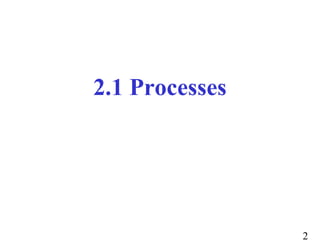
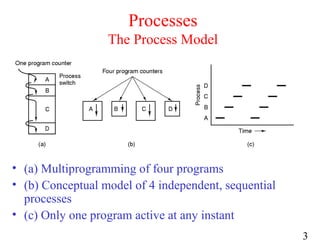
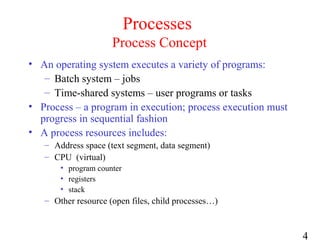




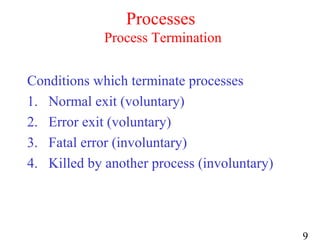





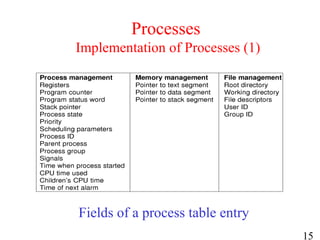
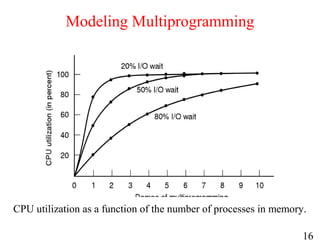




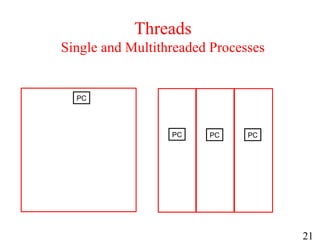
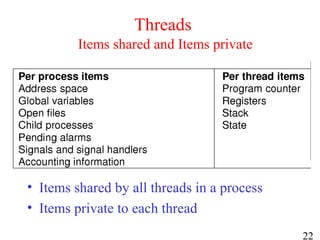




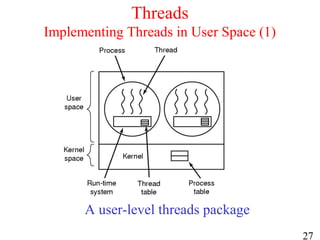




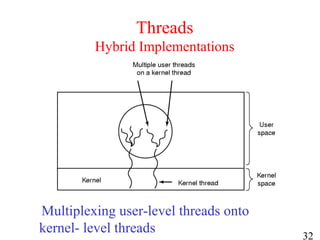






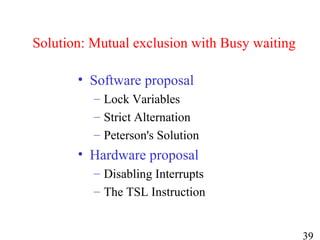




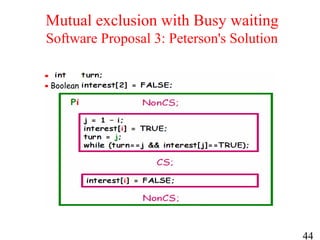

![46
Mutual exclusion with Busy waiting
Comment for Software Proposal 3:
Peterson's Solution
• Satisfy 3 conditions:
– Mutual Exclusion
• Pi can enter CS when interest[j] == F, or turn == i
• If both want to come back, because turn can only receive value
0 or 1, so one process enter CS
– Progress
• Using 2 variables distinct interest[i] ==> opposing cannot lock
– Bounded Wait: both interest[i] and turn change value
• Not extend into N processes](https://image.slidesharecdn.com/os-part-02-150330212852-conversion-gate01/85/Processes-and-Thread-OS_Tanenbaum_3e-46-320.jpg)

